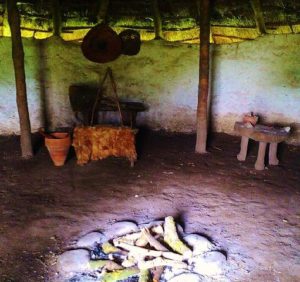
The photographer of the above image, Midnightblueowl, describes the above image from Wikimedia as:
The inside of the Bronze Age roundhouse reconstruction at Flag Fen in Eastern England.
Flag Fen, like Must Farm, was preserved in silt.
Peat bogs that originate in wetlands, or fenlands, are great preservers of living beings. A bronze age community 2 km north of Must Farm, was developed, lost to fire, and remained preserved, at Flag Fen, in Cambridgeshire, under similar conditions to those at Must Farm. Flag Fen is described by Wikipedia:
Flag Fen, east of Peterborough,[1] England, is a Bronze Age site developed about 3500 years ago, comprising over 60,000 timbers, arranged in five very long rows,[2] creating a wooden causeway (around 1 km long) across the wet fenland.
. . . . Archaeologists believe that the community was destroyed by a fire at the end of the Bronze Age, which damaged the posts that held the homes above the waterlogged earth, causing the dwellings to collapse into the river and forcing the inhabitants to hastily flee. The effects of the fire then carbonized the remains of the collapsed buildings, helping to preserve them.[11]
From there, the anaerobic conditions generated by deposited silt from the fens protected the wood, posts, and rafters of the collapsed structures from rotting away under the influence of air and bacteria.
For more information, read the complete Wikipedia article.
Visit the next page to see how travelers could travel safely from one area of a wetland to another.



